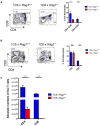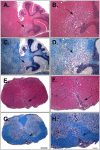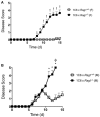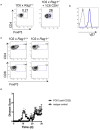Endogenous T Cell Receptor Rearrangement Represses Aggressive Central Nervous System Autoimmunity in a TcR-Transgenic Model on the Non-Obese Diabetic Background
- PMID: 32010149
- PMCID: PMC6974510
- DOI: 10.3389/fimmu.2019.03115
Endogenous T Cell Receptor Rearrangement Represses Aggressive Central Nervous System Autoimmunity in a TcR-Transgenic Model on the Non-Obese Diabetic Background
Abstract
The T cell response to central nervous system (CNS) antigen in experimental autoimmune encephalomyelitis (EAE) permits one to model the immune aspects of multiple sclerosis. 1C6 transgenic mice on the non-obese diabetic (NOD) background possess a class II-restricted T cell receptor (TcR; Vα5-Vβ7) specific for the encephalitogenic peptide myelin oligodendrocyte glycoprotein (MOG)[35-55]. It remains to be determined what role is played by allelic inclusion in shaping the TcR repertoire of these mice. Here, we show that 1C6 T cells display substantial promiscuity in their expression of non-transgenically derived Vα chains. Further, enforced expression of the transgenic TcR in 1C6 × Rag1-/- mice profoundly disrupted thymic negative selection and led to a sharp decrease in the number of mature peripheral T cells. 1C6 × Rag1-/- mice developed spontaneous EAE at a significant frequency and rapidly developed fatal EAE upon immunization with myelin oligodendrocyte glycoprotein (MOG)[35-55]. Passive transfer of 1C6 × Rag1+/+ CD4+ T cells, but not CD8+ T cells or B cells, partially rescued 1C6 × Rag1-/- mice from severe EAE. FoxP3+ CD4+ Treg cells were present in the CNS of immunized 1C6 mice, as well as immunized 1C6 × Rag1-/- that had been supplemented with 1C6 CD4+ T cells. However, they were not observed in 1C6 × Rag1-/- that did not receive Rag1-sufficient 1C6 CD4+. Further, in vivo blockade of Treg accelerated the onset of symptoms in 1C6 mice immunized with MOG[35-55], indicating the pertinence of Treg-mediated control of autoimmune inflammation in this model. Thus, TcR allelic inclusion is crucial to the generation of FoxP3+ CD4+ T cells necessary for the suppression of severe CNS autoimmunity.
Keywords: 1C6; EAE (experimental autoimmune encephalomyelitis); FoxP3; RAG; TCR transgenic mice; Treg—regulatory T cell; allelic exclusion; non-obese diabetic (NOD).
Copyright © 2020 Yeola, Ignatius Arokia Doss, Baillargeon, Akbar, Mailhot, Balood, Talbot, Anderson, Lacroix and Rangachari.
Figures






Similar articles
-
A transgenic model of central nervous system autoimmunity mediated by CD4+ and CD8+ T and B cells.J Immunol. 2012 Mar 1;188(5):2084-92. doi: 10.4049/jimmunol.1102186. Epub 2012 Jan 25. J Immunol. 2012. PMID: 22279107 Free PMC article.
-
A GMCSF-Neuroantigen Tolerogenic Vaccine Elicits Systemic Lymphocytosis of CD4+ CD25high FOXP3+ Regulatory T Cells in Myelin-Specific TCR Transgenic Mice Contingent Upon Low-Efficiency T Cell Antigen Receptor Recognition.Front Immunol. 2019 Jan 10;9:3119. doi: 10.3389/fimmu.2018.03119. eCollection 2018. Front Immunol. 2019. PMID: 30687323 Free PMC article.
-
T cell-depleted splenocytes from mice pre-immunized with neuroantigen in incomplete Freund's adjuvant involved in protection from experimental autoimmune encephalomyelitis.Immunol Lett. 2014 Jan-Feb;157(1-2):38-44. doi: 10.1016/j.imlet.2013.11.001. Epub 2013 Nov 9. Immunol Lett. 2014. PMID: 24220208
-
Regulatory T cells in spontaneous autoimmune encephalomyelitis.Immunol Rev. 2001 Aug;182:122-34. doi: 10.1034/j.1600-065x.2001.1820110.x. Immunol Rev. 2001. PMID: 11722629 Review.
-
The Non-Obese Diabetic Mouse Strain as a Model to Study CD8(+) T Cell Function in Relapsing and Progressive Multiple Sclerosis.Front Immunol. 2015 Oct 22;6:541. doi: 10.3389/fimmu.2015.00541. eCollection 2015. Front Immunol. 2015. PMID: 26557120 Free PMC article. Review.
Cited by
-
Biological Sex As a Critical Variable in CD4+ Effector T Cell Function in Preclinical Models of Multiple Sclerosis.Antioxid Redox Signal. 2022 Jul;37(1-3):135-149. doi: 10.1089/ars.2021.0202. Epub 2022 Jan 4. Antioxid Redox Signal. 2022. PMID: 34538129 Free PMC article. Review.
-
Myelin-reactive B cells exacerbate CD4+ T cell-driven CNS autoimmunity in an IL-23-dependent manner.Nat Commun. 2024 Jun 26;15(1):5404. doi: 10.1038/s41467-024-49259-0. Nat Commun. 2024. PMID: 38926356 Free PMC article.
References
Publication types
MeSH terms
Substances
LinkOut - more resources
Full Text Sources
Research Materials

